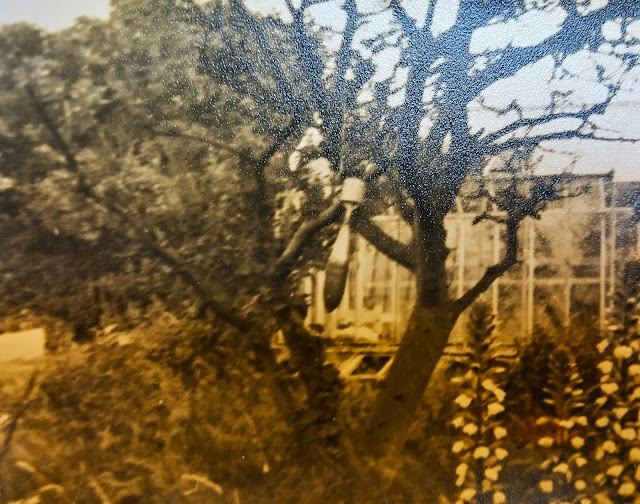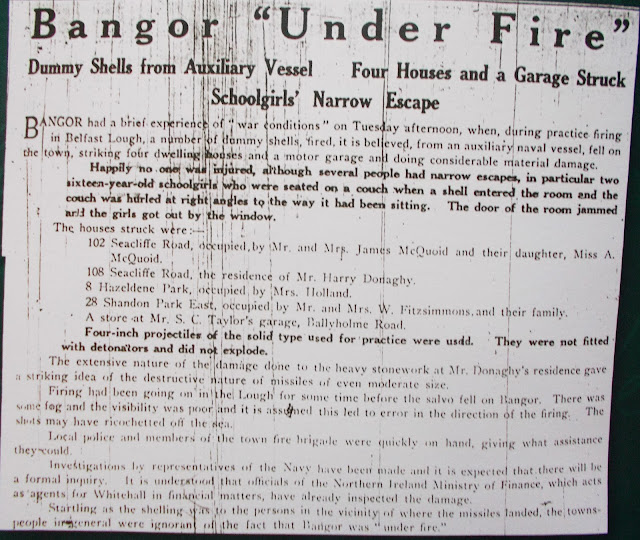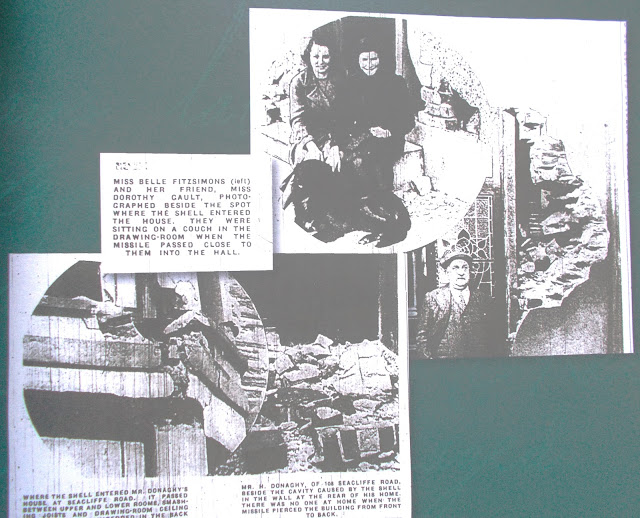Joining the dots.
WW2 was still a big influence on life when I was born. I suppose it wasn’t much more than a decade
and a half earlier, but its effects were still all around. Many of the houses near my childhood home
were inhabited by single women, and many of those had been widowed by the
war. Local fishing boats often lost nets
when they snagged old mines. There were
constant stories of these being shot to make them explode, resulting in
complaints from the fishermen who lost nets as a result. There were occasional problems with the
souvenirs (Well, it was assumed to have been a souvenir, but I do wonder about
that), that the servicemen brought home too, as below.
By the mid 70’s when I was in my teens but still at school,
the troubles were of course at their rampant worst. You would think that in such a situation, our
local Police would take explosives seriously, but ……..
On a beautiful summer’s day during the school holidays, I
arrived home to news that the Seacliffe Road, close to where we lived was
closed because someone had found a bomb.
This road runs around Bangor’s shoreline, and overlooks the town’s old
harbour which is called the Long Hole.
Of course, for a 12 or 13 year old, this was too good to miss, so I ran
over to see what was going on.
Fortunately, for once in my life I did something sensible, grabbing the
family Instamatic on my way out in case there might be a photo opportunity.
Someone on site told me that the house was being cleared
after the aging resident had died, and that a WW2 bomb had been found in the
roof space. They also said that the bomb
had been taken out to the back garden of the house. I knew there was a lane behind this row of
houses, and that the back gardens were easy to access, so I went there to try
to see the bomb. Now things got slightly
worrying.
I had expected to meet a policeman and be turned back, but
instead, I was able to walk up the steps into the garden unhindered. The bomb, as in the picture hereabouts was
hanging from a tree on a bit of old washing line. The slightly worrying part was that I wasn’t
the only one who had decided to come into the garden to see the bomb. Two local kids, about 6 or 7 years old were
there too, and because they couldn’t reach the bomb, one of them had climbed
into the tree and was shaking the branch that the washing line was attached to
with all his might, while the other stood below the bomb trying to grab at it
as it swung. I might have been daft at
12 or 13 years of age, but even I wasn’t that daft! Fortunately, the two kids cleared off when I
arrived, and I was able to get this picture of the bomb. The police who were supposed to be guarding
it, I learned afterwards, had been invited into the house for a quick cup of
tea while awaiting the arrival of the bomb squad.
I took this picture of a WW2 bomb found in the roof space of a house on the Seacliffe Road, Bangor in the early 70's. It was developed and printed in my school's photo lab, but it looks like I didn't wash the chemicals off very well. And no, in answer to the obvious question, I have no idea why the bomb was left hanging from a tree while awaiting the bomb squads arrival.
So here is a question if there are any WW2 munitions
experts out there in internet land. It
looks to me like something that was dropped from a plane rather than a mortar
bomb. Can anyone confirm that, or can
anyone tell from this slightly blurry shot if it was a German or a British
Bomb? I ask this because Bangor was
bombed by a single aircraft on 13th September 1940, and a number of
the bombs that were dropped failed to explode.
Bangor was bombed again in April 1941 during the blitz on Belfast
Mention is needed here of some other incidents from WW2 in this area. The bomb was found in the roof space of either number 106, or 108 Seacliffe Road. Strangely, No:108 and a few others in the town were hit by friendly fire on 2nd January 1940, from a ship testing its guns. It was part of a convoy that was forming up in Belfast lough.
Below is a newspaper report and a few photos from the time. These are taken from a local history book
called “Memories Of Bangor 1939-1945”, (Thanks Sam).
The WartimeNI site has an article giving further details of this incident here: R.F.A. Serbol bombs Bangor, Co. Down - WartimeNI. It even includes a picture of the offending ship, The Serbol. Since the circumstances of this friendly fire incident are well known, it cannot be linked to the bomb in my photo.
Now to the single plane firebombs from 13th September 1940. I actually didn't know of this incident until I started researching this story. The Wartime NI site has good coverage of it here: The Luftwaffe's first attack on Bangor, Co. Down - WartimeNI. The bombs from that plane seem to have been released on a single pass over the town, which may well have brought the plane over this part of the Seacliffe Road. Attitudes to firebombs must have been far more lax back then, because newspaper reports from the time (see the WartimeNI article), show two railway workers holding one of the unexploded devices. It is much smaller than the bomb in my photo, so we can probably discount this incident as being the source of the bomb I photographed all those years ago.
Lastly the Belfast Blitz. These were heavy raids, the principal targets of which were most likely the Harland and Wolff shipyard, and the Shorts aircraft factory, but many other factories in Belfast were involved in the war effort from clothing to castings, it was all there in a relatively compact area. I find it very difficult, despite more casual attitudes towards explosives that someone would bring a live bomb home to their family as a souvenir. As mentioned above, bombs did fall on Bangor during the blitz, in fact an unexploded one was found in 2008 during the construction of a local sixth form academy. I suppose we will never be able to say with any certainty how this bomb got to be in the roof space of that house now, but knowing if it was German or British would add another dot to the overall picture, so if you can help, please drop a message to this site.











Comments
Post a Comment
Feel free to leave a comment: I don't use or sell your data, and you will not receive any spam mail as a result.